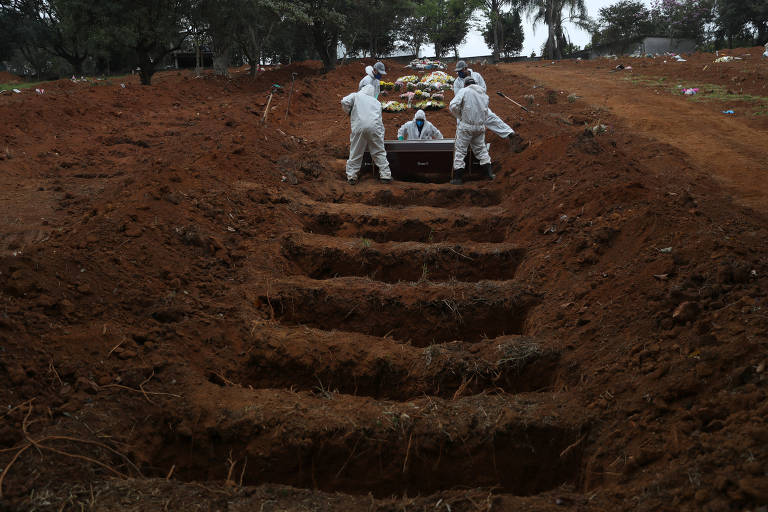Due to limitations imposed by the federal government, journalists from Estadão, G1, O Globo, Extra, Folha and UOL will jointly collect and publish figures from the state health departments on deaths and those who are infected by the new coronavirus.
In response to the Jair Bolsonaro administration's decision to restrict access to data on the Covid-19 pandemic, O Estado de S. Paulo, Folha de S.Paulo, O Globo, Extra, G1 and UOL decided to form a partnership and work collaboratively to gather appropriate information in the 26 states and the Federal District.
In an unprecedented initiative, teams from the news organizations will distribute tasks and share information obtained so that Brazilians can know about the progress and total number of deaths caused by Covid-19, as well as the consolidated numbers of tested cases with positive results for the new coronavirus. The daily report will be closed at 8 pm.
The federal government, through the Ministry of Health, was supposed to be the natural source of these figures, but recent attitudes of authorities and the president himself put in question the availability of data and their accuracy.
Changes made by the Ministry of Health in the publication of its pandemic assessment have reduced the quantity and quality of the data. First, the time of disclosure, which was at 5pm in the administration of Minister Luiz Henrique Mandetta (until April 17th), was shifted to 7pm and then to 10pm. This makes it difficult or impossible to publish the data in TV and print media. "No more stories in Jornal Nacional," said President Jair Bolsonaro, in a tone of mockery, commenting on the shift.
The second change was of a qualitative nature. The public dashboard on which the ministry publishes the number of dead and infected was taken off the air last Thursday night. When it returned, after more than 19 hours, it began to present only information on the "new" cases, i.e., recorded on the day itself. The consolidated figures and the history of the disease since its beginning have disappeared. Links to downloads of data in table format, essential for analysis by researchers and journalists, have also been removed from the site.
Among the items no longer published are: curve of new cases by reporting date and epidemiological week; cumulative cases by reporting date and epidemiological week; deaths by reporting date and epidemiological week; and cumulative deaths by reporting date and epidemiological week.
This Sunday (7), the government announced that it would resume its reporting on the disease. But it showed conflicting figures, released within a few hours.
Due to the omissions, the partnership between the media will collect the figures directly from the state health departments. Each news organization will publish the results in their respective channels. The group will call the public's attention if there is no transparency and regularity in the disclosure of data by the states.
"In an organized society like the Brazilian one, it is practically impossible to omit or distort data as fundamental as the impact of a pandemic. With this joint initiative of data gathering with Brazilian states, we make it clear that the news media will not allow our readers to remain unaware of the extent of covid-19," said Sérgio Dávila, director of Folha's editorial staff.
"It's our daily responsibility to transmit reliable information to society. And now, at the most acute moment of the pandemic, we need to ensure the population has access to correct data as soon as possible, no matter what the cost," said Murilo Garavello, director of Content at UOL.
"The mission of journalism is to inform. In spite of the natural competition between news outlets, the current pandemic requires an effort so that Brazilians have the most correct number of people infected and dead," said Ali Kamel, general director of journalism at Globo (TV Globo, GloboNews and G1). "Faced with the attitude of the Ministry of Health, the joint effort of the media has this goal: to give Brazilians a reliable figure.
"At this crucial moment, we are leaving our competition aside for the common good: to bring to society the most precise data possible about the pandemic. This information guides people and public policies. Without it, the country dives into a blind flight. Journalism will play its part," said Alan Gripp, O Globo newsroom director.
"Journalism has the mission to bring the population the most accurate figures about the pandemic. It is essential to know the real extent of the facts. These data are decisive for people to know how to act in this very difficult moment," said Humberto Tziolas, director of Extra.
"It's sad to have to compile a survey to replace an omission by the federal authorities. Transparency and honesty should be unshakeable values in managing this pandemic. We will continue fulfilling our mission, which is to inform society," said João Caminoto, director of journalism at Grupo Estado.
